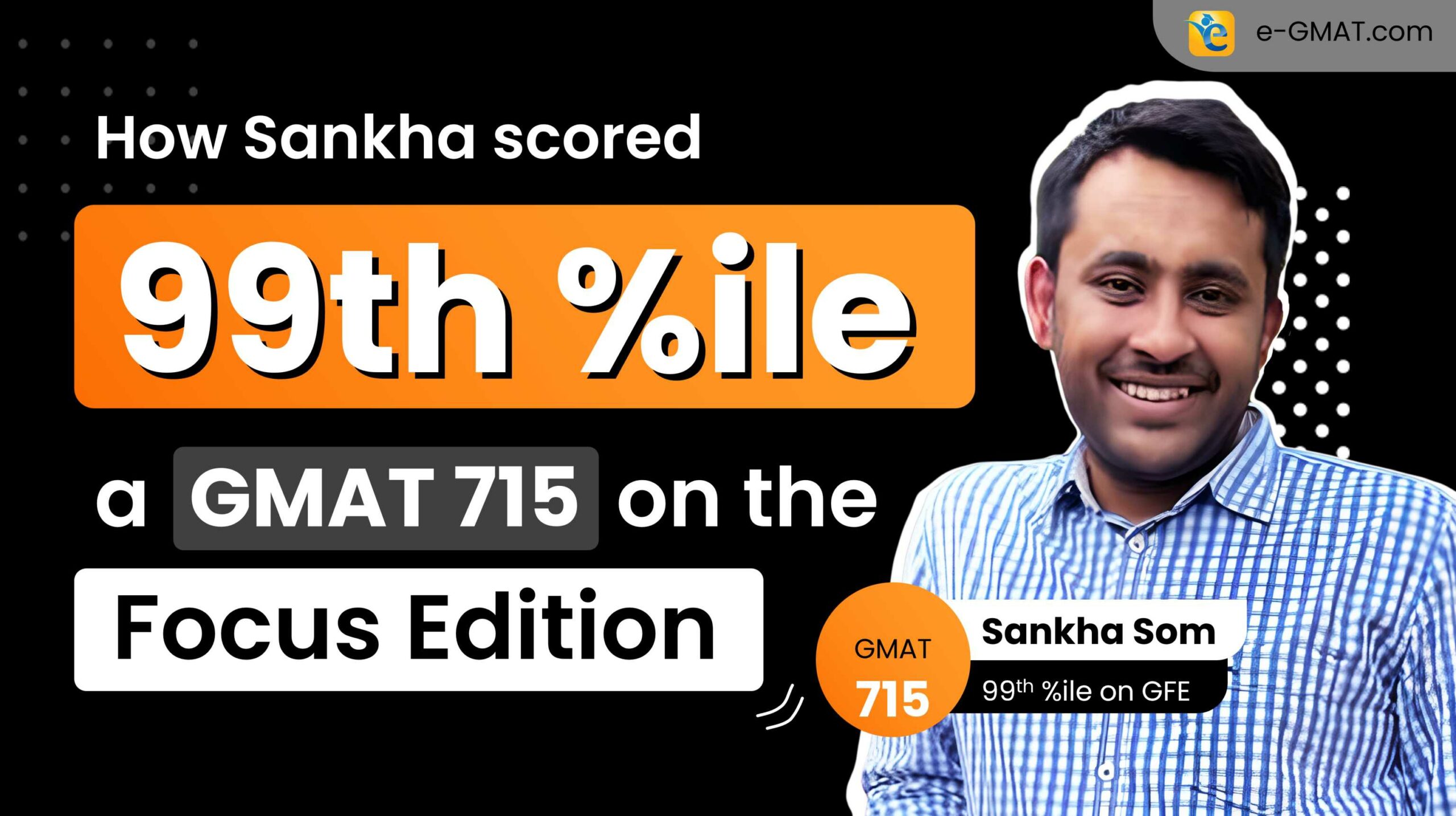For most GMAT aspirants, breaking through performance plateaus requires a complete overhaul of the study strategy. For Soham, a Bachelor of Arts graduate in Economics, this journey would challenge not just his academic approach but his entire mindset about preparation and performance.
Working as a data analyst, Soham brought analytical skills to his GMAT preparation. Yet his initial score of 565 revealed that professional data expertise alone wouldn’t be enough. Despite having previous experience with the Indian CAT exam, the GMAT demanded a fundamentally different approach – one that would push him to reconsider everything he thought he knew about test preparation.
The transformation that followed wasn’t just about the impressive 80-point score improvement to 645. It was about developing a structured, data-driven methodology that would challenge his assumptions and ultimately prove that with the right strategy, even the most daunting obstacles could become stepping stones to success.
Strategic Transformation: From Intuition to Process
Soham’s initial approach to GMAT preparation relied heavily on intuition and strategies that had worked for other exams. “Having taken the CAT exam twice, I thought RC wasn’t really challenging for me,” he explains. “But GMAT verbal, if you compare it with any other entrance test, is quite different in terms of raw difficulty.”
This realization led to the first major shift in his preparation strategy. While Reading Comprehension seemed familiar territory, Critical Reasoning emerged as an unexpected challenge. “CR wasn’t extensively tested in any Indian exam,” Soham notes. “The primary challenge in CR is that almost every time there are two options that look quite similar. Navigating between those two options to actually select the right one – that’s what makes the difference.”
Watch Soham master the Pre-thinking approach for CR and its impact:
The breakthrough came when Soham committed fully to structured pre-thinking, a decision that would transform his approach across all verbal sections:
STRATEGIC EVOLUTION
Before:
- Relying on intuition and previous exam experience
- Rushing through questions without systematic analysis
- Minimal structured preparation for Critical Reasoning
After:
- Systematic pre-thinking for every question type
- Comprehensive error logging and pattern analysis
- Visualization techniques for Reading Comprehension
The implementation wasn’t immediate. But, this patience paid off dramatically in his Critical Reasoning performance, where his hard accuracy remained above 55%, indicating strong ability. In the image below, where we can see the accuracy progression for hard questions, we can see how Soham’s hard accuracy improved to 55%+ and stayed there.

What made this transformation particularly effective was Soham’s methodical approach to internalizing the strategy. He developed a three-part system:
- Creating multiple scenarios for each question: “The basic fundamental of pre-thinking is to create alternate scenarios. For assumption questions, you create different types of scenarios, and one of them would match the answer choice.”
- Comprehensive error logging: “The funny thing about error logs is you won’t get their importance by just doing 10 or 20 questions. But when you’re down to about 60-75 questions and you look at your error log, you start seeing the patterns.”
- Visualization techniques for Reading Comprehension: “I started imagining an imaginary author in my head. When you put a face to it, the comprehension level goes up because visualizing something versus just reading it makes a big difference.”
This systematic approach yielded impressive results. By his final preparation phase, Soham had achieved a 70% accuracy rate on hard Reading Comprehension questions and improved his Critical Reasoning accuracy from 50% to 65% on challenging problems. More importantly, he had developed a repeatable process that worked consistently under pressure.
Data-Driven Preparation: Turning Numbers into Action
The systematic approach Soham developed for verbal would soon extend into a comprehensive, data-driven preparation strategy. As a data analyst by profession, he understood the value of metrics – but GMAT preparation would teach him how to turn these numbers into actionable insights.
Scholaranium became his primary tool for this transformation.
“It’s an amazing engine because it has features for every level of prep,” Soham explains. “Even if I needed to improve on a very specific subtopic within number properties, I could create a custom quiz targeting just that area. That’s the level of detail it provides.”
Soham Leveraged Scholaranium Features and Data analytics:
This granular approach to improvement revealed itself in his performance data, as we can see in the image below, where he steadily improved to a 70% accuracy for hard questions in Number Properties and Word Problems:

PERFORMANCE MILESTONES
Number Properties:
- Initial Hard Accuracy: 35%
- Final Hard Accuracy: 70%
- Key Factor: Topic-specific drilling
Word Problems:
- Initial Hard Accuracy: 60%
- Final Hard Accuracy: 70%
- Key Factor: Custom quiz creation
Perhaps the most significant impact came from his strategic use of the PACE engine, which saved him approximately 25 hours of preparation time. “The PACE engine actually calculates your final path based on all the questions you’ve attempted,” Soham explains. “It’s not some hocus-focus magic – it’s based on actual statistics from your diagnostic tests.”

His approach to utilizing these tools evolved into a three-tier system:
- Started with comprehensive diagnostics to identify specific weaknesses, allowing him to create targeted study plans based on actual performance data rather than assumptions.
- Created custom quiz sets focusing on particular subtopics, enabling him to drill down into specific areas like number properties or word problems where he needed improvement.
- Maintained detailed Error Logs for all his mocks to identify patterns in his performance, helping him understand where his scores were improving or declining over time.
The impact of this analytical approach extended beyond just numbers. “When I saw that I did well on diagnostic tests and certain topics were skippable for me, it gave me a sense of confidence,” Soham reflects. “That psychological boost was crucial, especially since I had always been scared of quant.”
His data-driven methodology proved particularly effective in cementing concepts: “What cementing does is ask you to consistently deliver solid results. The threshold values aren’t arbitrary – they test whether you actually have the ability, whether you’re truly conceptually strong.”
This insistence on meeting thresholds, while challenging, proved invaluable. “Sometimes I’d miss my cutoff by just 5 or 10 percent, and I’d be tempted to move on,” Soham admits. “But the mentors pushed me back: ‘You’re not good enough, go back, learn again, then do it.’ That discipline made all the difference in my final performance.”
Mock Test Journey: Where Strategy Meets Reality
Soham’s mock journey revealed both the strength of his preparation and areas needing refinement. Consistently scoring between 645 and 675, his performance showed promise – but also highlighted the importance of execution under exam conditions.
“After completing the course curriculum, I took my first mock,” Soham recalls. “That first score wasn’t satisfying at all. Instead of dwelling on it, I decided to look inward and analyze what needed to change.” This analytical approach to mock testing evolved into a systematic process.
His key realization was that surface-level analysis wouldn’t suffice. “Initially, my analysis was very superficial,” he admits. “After a couple of mocks, I realized I wasn’t taking anything meaningful from them. Even if there’s no score improvement, there should still be insights.”
Soham explains his strategies in this video below:
This understanding led him to develop a more rigorous analysis approach. He created detailed Excel sheets tracking his performance across mocks, identifying patterns and trends that would have been impossible to spot through casual review. More importantly, he learned to analyze his performance with a neutral mindset, setting aside frustration to focus on actionable insights.
The mock phase also helped him refine his section strategy. “I was still pondering section order even one day before my actual exam,” he notes. After experimentation, he settled on: Quant, Verbal, break, then Data Insights. This arrangement played to his strengths while managing his energy levels throughout the test.
Most crucially, the mock tests revealed the importance of consistent execution. “Having a strategy isn’t enough,” Soham emphasizes. “You need enough time to practice executing those strategies under test conditions. I had two or three strategies I was executing for the very first time on test day – that’s dangerous.” This hard-won wisdom, combined with his entire preparation journey, led to several crucial insights that could benefit future GMAT aspirants.
Mental Game: When Data Meets Determination
For Soham, one of the most challenging aspects of GMAT preparation wasn’t technical – it was psychological. Despite his professional background in data analysis, he faced an unexpected obstacle: his own ego.
“I was quite headstrong at first,” he admits. “When you actually get your teeth into what GMAT demands, you understand what your strengths really are. Sometimes I would just skim through questions, go past them without realizing it. And that’s counterproductive – you’re just wasting time.”
This realization led to what he considers a crucial turning point in his preparation:
MINDSET BREAKTHROUGHS
- Accepting the need to start from basics
- Acknowledging areas of weakness
- Developing patience with the learning process
- Building mental stamina for the full exam
The impact of mental stamina became particularly apparent during his mock tests. While sectional practice was manageable, combining three sections created a new challenge. “When you take sectional tests, you’re done with it, it’s over,” Soham explains. “But in a mock, when you finish your first section, you realize two more sections are left. You need to maintain the same level of mental stamina throughout.”
His test-day strategy evolved from these experiences. Arriving 55 minutes early to the test center, Soham implemented an unusual but effective warm-up routine: “In the back seat of my car, I opened GMAT Club and solved a couple of medium and hard questions. Not to get them right, but just to make myself comfortable and feel more confident.”
Despite careful preparation, test day brought its own challenges. “I was telling myself constantly during the break, ‘DI timing is crucial, don’t mess up the time.’ But ultimately, even after creating a proper strategy, I still spent those extra minutes on initial questions and had to guess on two or three at the end.”
This experience reinforced his most important lesson: “Strategy should always be coupled with execution. Ideally, you should be done with all your potential strategies before you take the last mock, giving yourself enough time to actually practice executing them.”
The transformation in his approach yielded more than just a better score – it provided valuable insights for his future academic journey. “Going back to basics without any ego and just putting in the hard work will always lead you to results,” he reflects. “That’s a fact.” These lessons would prove especially crucial during his intensive mock test preparation phase.
Key Learnings: Beyond the Score
At the end of this journey that transformed both his approach to learning and his GMAT performance, Soham’s experience offers valuable insights for other test-takers.

“From watching these success story videos for motivation to actually being here – it’s surreal,” Soham reflects. “I hope sharing my journey helps someone else achieve their goals.”
His key advice for GMAT aspirants centers on three fundamental principles:
- Trust the Process: “Pre-thinking might seem time-consuming initially, but accuracy matters more than speed. When you internalize the process, one of your scenarios will match the answer choice 90% of the time.”
- Embrace Detailed Analytics: “You won’t see the value of an error log after just 10 or 20 questions. But when you’ve logged 60-75 questions, you start seeing patterns that can transform your performance.”
- Practice Strategic Execution: “Create multiple strategies and alternatives for test day. More importantly, give yourself enough time to practice executing these strategies before the actual exam.”
Beyond these technical aspects, Soham emphasizes the importance of mindset: “Going back to basics without ego and putting in consistent hard work will always lead to results. That’s not just true for the GMAT – it’s a life lesson.”
Soham also emphasizes on how having a mentor can make the GMAT journey easy:
With his GMAT journey complete, Soham looks ahead to his next academic challenges, carrying with him not just a higher score, but a transformed approach to learning and problem-solving. His journey from a 565 to a 645 proves that with the right strategy, dedication, and willingness to learn, significant improvements are possible – regardless of your starting point.
Are you planning to pursue MBA at top business schools? Let us help you conquer the first step of the process i.e., taking the GMAT. Take a free mock test to understand your baseline score and start your GMAT prep with our free trial. We are the most reviewed online GMAT Prep company with 2000+ five star reviews on GMATClub.















